Growth Opportunities: Baiada Poultry's Expansion into the Japan Market
VerifiedAdded on 2022/09/12
|7
|1948
|4
Report
AI Summary
This report examines the potential for Baiada Poultry, an Australian agribusiness company, to expand into the Japanese market. It provides an overview of Baiada Poultry's operations and products, followed by an analysis of the agriculture industry in both Australia and Japan. The report highlights the increasing demand for agriculture products in Japan, driven by health concerns and dietary shifts towards Western-style diets. It also considers consumer profiles in both countries, noting the growing preference for organic and healthy options in Japan. The report concludes that Baiada Poultry has a significant opportunity to grow its business by meeting the demand for healthy, semi-finished products in the Japanese agriculture market, suggesting that expansion into Japan could prove successful for the company. Desklib provides access to similar reports and solved assignments for students.

qwertyuiopasdfghjklzxcvbnmqw
ertyuiopasdfghjklzxcvbnmqwert
yuiopasdfghjklzxcvbnmqwertyui
opasdfghjklzxcvbnmqwertyuiop
asdfghjklzxcvbnmqwertyuiopasd
fghjklzxcvbnmqwertyuiopasdfgh
jklzxcvbnmqwertyuiopasdfghjkl
zxcvbnmqwertyuiopasdfghjklzxc
vbnmqwertyuiopasdfghjklzxcvb
nmqwertyuiopasdfghjklzxcvbnm
qwertyuiopasdfghjklzxcvbnmqw
ertyuiopasdfghjklzxcvbnmqwert
yuiopasdfghjklzxcvbnmqwertyui
opasdfghjklzxcvbnmqwertyuiop
asdfghjklzxcvbnmqwertyuiopasd
fghjklzxcvbnmqwertyuiopasdfgh
jklzxcvbnmrtyuiopasdfghjklzxcv
Marketing
ertyuiopasdfghjklzxcvbnmqwert
yuiopasdfghjklzxcvbnmqwertyui
opasdfghjklzxcvbnmqwertyuiop
asdfghjklzxcvbnmqwertyuiopasd
fghjklzxcvbnmqwertyuiopasdfgh
jklzxcvbnmqwertyuiopasdfghjkl
zxcvbnmqwertyuiopasdfghjklzxc
vbnmqwertyuiopasdfghjklzxcvb
nmqwertyuiopasdfghjklzxcvbnm
qwertyuiopasdfghjklzxcvbnmqw
ertyuiopasdfghjklzxcvbnmqwert
yuiopasdfghjklzxcvbnmqwertyui
opasdfghjklzxcvbnmqwertyuiop
asdfghjklzxcvbnmqwertyuiopasd
fghjklzxcvbnmqwertyuiopasdfgh
jklzxcvbnmrtyuiopasdfghjklzxcv
Marketing
Paraphrase This Document
Need a fresh take? Get an instant paraphrase of this document with our AI Paraphraser
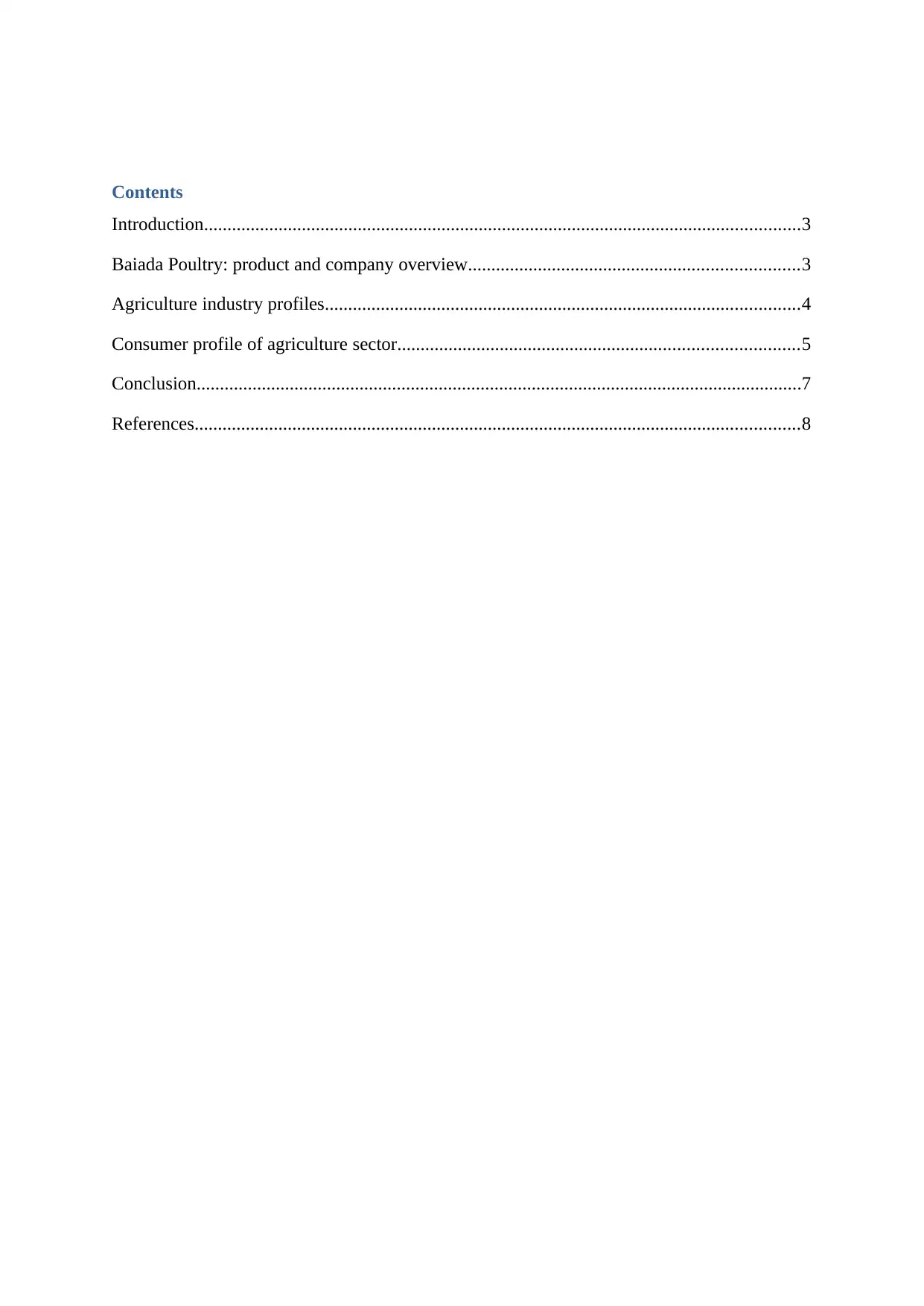
Contents
Introduction................................................................................................................................3
Baiada Poultry: product and company overview.......................................................................3
Agriculture industry profiles......................................................................................................4
Consumer profile of agriculture sector......................................................................................5
Conclusion..................................................................................................................................7
References..................................................................................................................................8
Introduction................................................................................................................................3
Baiada Poultry: product and company overview.......................................................................3
Agriculture industry profiles......................................................................................................4
Consumer profile of agriculture sector......................................................................................5
Conclusion..................................................................................................................................7
References..................................................................................................................................8
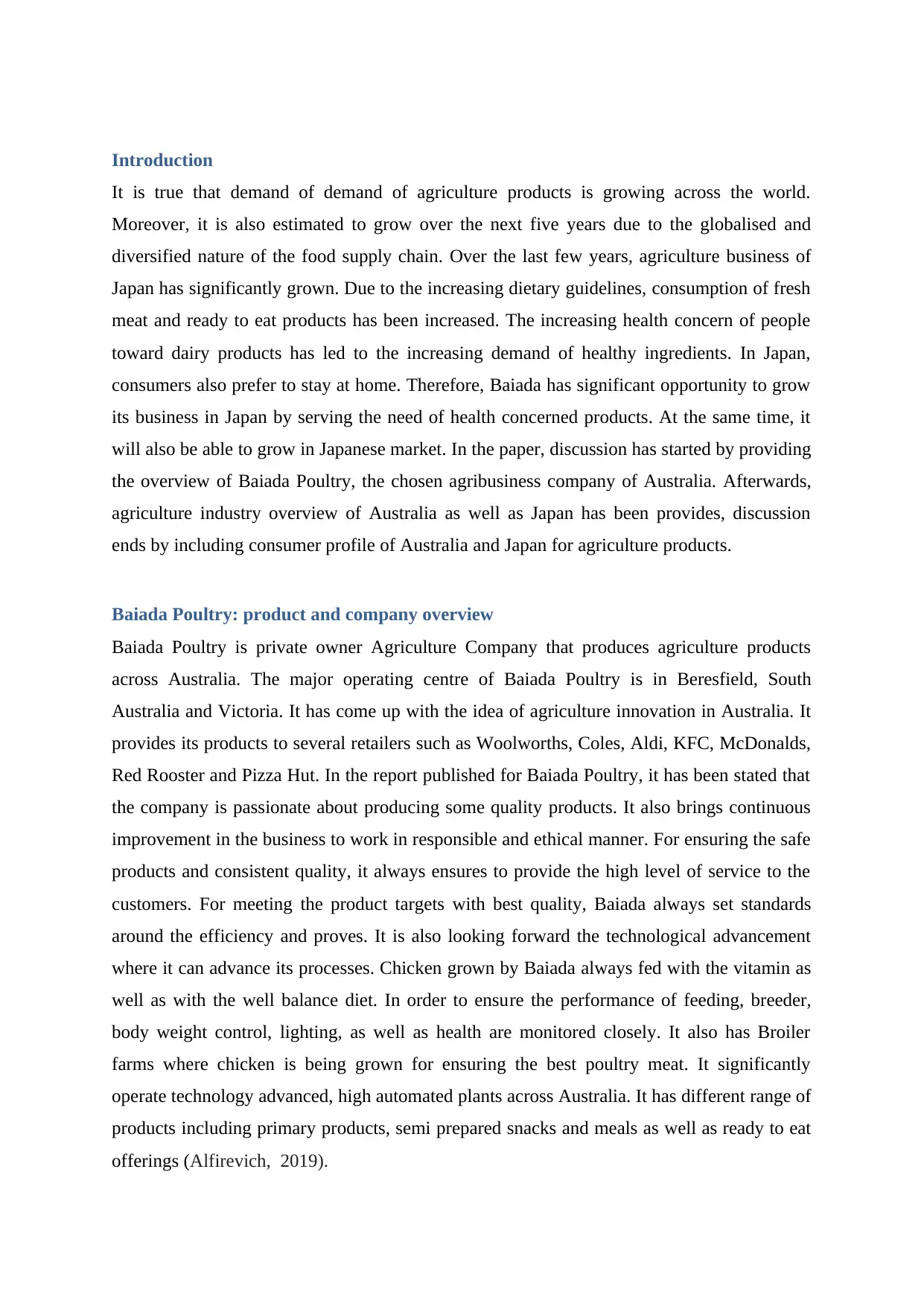
Introduction
It is true that demand of demand of agriculture products is growing across the world.
Moreover, it is also estimated to grow over the next five years due to the globalised and
diversified nature of the food supply chain. Over the last few years, agriculture business of
Japan has significantly grown. Due to the increasing dietary guidelines, consumption of fresh
meat and ready to eat products has been increased. The increasing health concern of people
toward dairy products has led to the increasing demand of healthy ingredients. In Japan,
consumers also prefer to stay at home. Therefore, Baiada has significant opportunity to grow
its business in Japan by serving the need of health concerned products. At the same time, it
will also be able to grow in Japanese market. In the paper, discussion has started by providing
the overview of Baiada Poultry, the chosen agribusiness company of Australia. Afterwards,
agriculture industry overview of Australia as well as Japan has been provides, discussion
ends by including consumer profile of Australia and Japan for agriculture products.
Baiada Poultry: product and company overview
Baiada Poultry is private owner Agriculture Company that produces agriculture products
across Australia. The major operating centre of Baiada Poultry is in Beresfield, South
Australia and Victoria. It has come up with the idea of agriculture innovation in Australia. It
provides its products to several retailers such as Woolworths, Coles, Aldi, KFC, McDonalds,
Red Rooster and Pizza Hut. In the report published for Baiada Poultry, it has been stated that
the company is passionate about producing some quality products. It also brings continuous
improvement in the business to work in responsible and ethical manner. For ensuring the safe
products and consistent quality, it always ensures to provide the high level of service to the
customers. For meeting the product targets with best quality, Baiada always set standards
around the efficiency and proves. It is also looking forward the technological advancement
where it can advance its processes. Chicken grown by Baiada always fed with the vitamin as
well as with the well balance diet. In order to ensure the performance of feeding, breeder,
body weight control, lighting, as well as health are monitored closely. It also has Broiler
farms where chicken is being grown for ensuring the best poultry meat. It significantly
operate technology advanced, high automated plants across Australia. It has different range of
products including primary products, semi prepared snacks and meals as well as ready to eat
offerings (Alfirevich, 2019).
It is true that demand of demand of agriculture products is growing across the world.
Moreover, it is also estimated to grow over the next five years due to the globalised and
diversified nature of the food supply chain. Over the last few years, agriculture business of
Japan has significantly grown. Due to the increasing dietary guidelines, consumption of fresh
meat and ready to eat products has been increased. The increasing health concern of people
toward dairy products has led to the increasing demand of healthy ingredients. In Japan,
consumers also prefer to stay at home. Therefore, Baiada has significant opportunity to grow
its business in Japan by serving the need of health concerned products. At the same time, it
will also be able to grow in Japanese market. In the paper, discussion has started by providing
the overview of Baiada Poultry, the chosen agribusiness company of Australia. Afterwards,
agriculture industry overview of Australia as well as Japan has been provides, discussion
ends by including consumer profile of Australia and Japan for agriculture products.
Baiada Poultry: product and company overview
Baiada Poultry is private owner Agriculture Company that produces agriculture products
across Australia. The major operating centre of Baiada Poultry is in Beresfield, South
Australia and Victoria. It has come up with the idea of agriculture innovation in Australia. It
provides its products to several retailers such as Woolworths, Coles, Aldi, KFC, McDonalds,
Red Rooster and Pizza Hut. In the report published for Baiada Poultry, it has been stated that
the company is passionate about producing some quality products. It also brings continuous
improvement in the business to work in responsible and ethical manner. For ensuring the safe
products and consistent quality, it always ensures to provide the high level of service to the
customers. For meeting the product targets with best quality, Baiada always set standards
around the efficiency and proves. It is also looking forward the technological advancement
where it can advance its processes. Chicken grown by Baiada always fed with the vitamin as
well as with the well balance diet. In order to ensure the performance of feeding, breeder,
body weight control, lighting, as well as health are monitored closely. It also has Broiler
farms where chicken is being grown for ensuring the best poultry meat. It significantly
operate technology advanced, high automated plants across Australia. It has different range of
products including primary products, semi prepared snacks and meals as well as ready to eat
offerings (Alfirevich, 2019).
⊘ This is a preview!⊘
Do you want full access?
Subscribe today to unlock all pages.

Trusted by 1+ million students worldwide
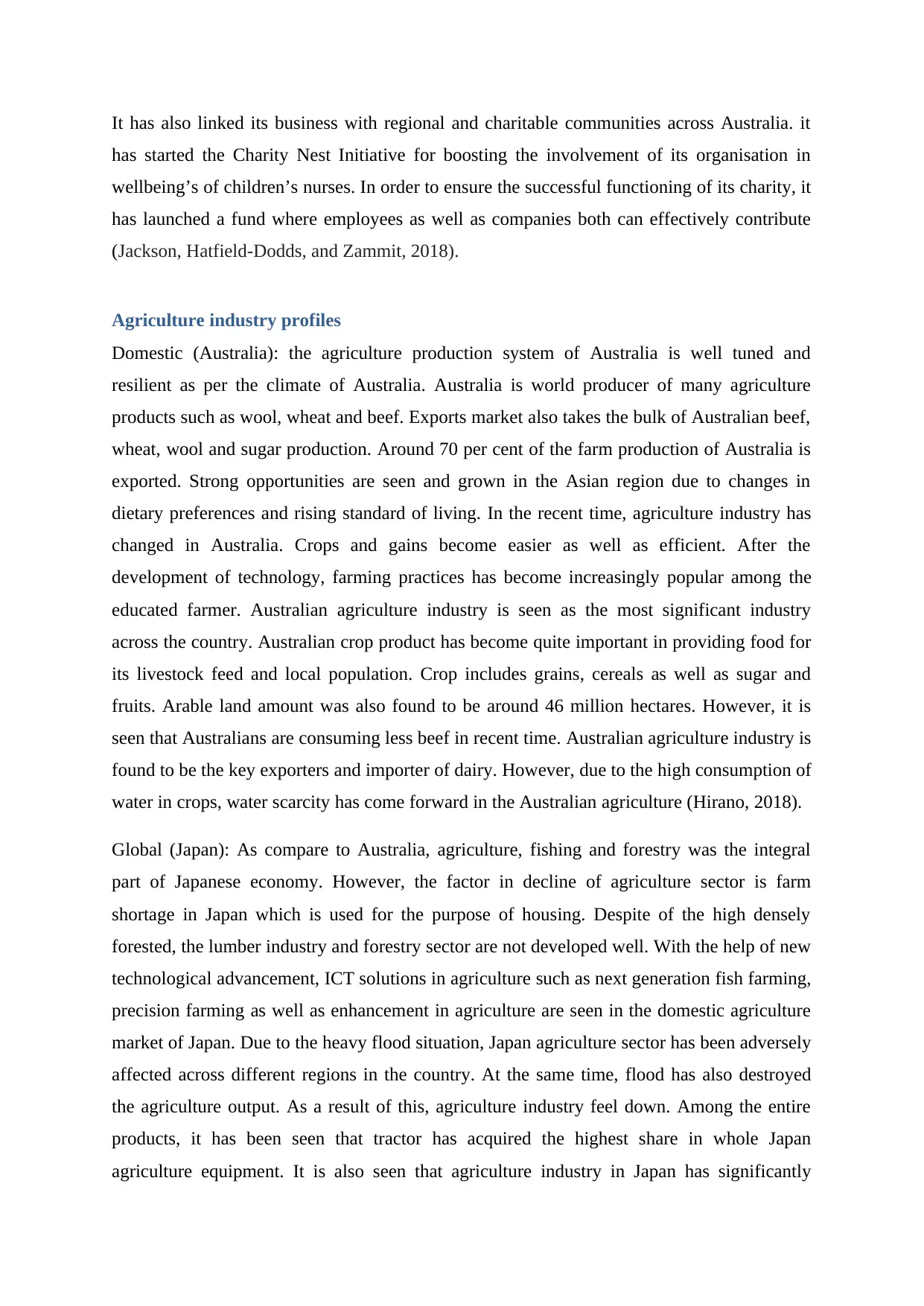
It has also linked its business with regional and charitable communities across Australia. it
has started the Charity Nest Initiative for boosting the involvement of its organisation in
wellbeing’s of children’s nurses. In order to ensure the successful functioning of its charity, it
has launched a fund where employees as well as companies both can effectively contribute
(Jackson, Hatfield-Dodds, and Zammit, 2018).
Agriculture industry profiles
Domestic (Australia): the agriculture production system of Australia is well tuned and
resilient as per the climate of Australia. Australia is world producer of many agriculture
products such as wool, wheat and beef. Exports market also takes the bulk of Australian beef,
wheat, wool and sugar production. Around 70 per cent of the farm production of Australia is
exported. Strong opportunities are seen and grown in the Asian region due to changes in
dietary preferences and rising standard of living. In the recent time, agriculture industry has
changed in Australia. Crops and gains become easier as well as efficient. After the
development of technology, farming practices has become increasingly popular among the
educated farmer. Australian agriculture industry is seen as the most significant industry
across the country. Australian crop product has become quite important in providing food for
its livestock feed and local population. Crop includes grains, cereals as well as sugar and
fruits. Arable land amount was also found to be around 46 million hectares. However, it is
seen that Australians are consuming less beef in recent time. Australian agriculture industry is
found to be the key exporters and importer of dairy. However, due to the high consumption of
water in crops, water scarcity has come forward in the Australian agriculture (Hirano, 2018).
Global (Japan): As compare to Australia, agriculture, fishing and forestry was the integral
part of Japanese economy. However, the factor in decline of agriculture sector is farm
shortage in Japan which is used for the purpose of housing. Despite of the high densely
forested, the lumber industry and forestry sector are not developed well. With the help of new
technological advancement, ICT solutions in agriculture such as next generation fish farming,
precision farming as well as enhancement in agriculture are seen in the domestic agriculture
market of Japan. Due to the heavy flood situation, Japan agriculture sector has been adversely
affected across different regions in the country. At the same time, flood has also destroyed
the agriculture output. As a result of this, agriculture industry feel down. Among the entire
products, it has been seen that tractor has acquired the highest share in whole Japan
agriculture equipment. It is also seen that agriculture industry in Japan has significantly
has started the Charity Nest Initiative for boosting the involvement of its organisation in
wellbeing’s of children’s nurses. In order to ensure the successful functioning of its charity, it
has launched a fund where employees as well as companies both can effectively contribute
(Jackson, Hatfield-Dodds, and Zammit, 2018).
Agriculture industry profiles
Domestic (Australia): the agriculture production system of Australia is well tuned and
resilient as per the climate of Australia. Australia is world producer of many agriculture
products such as wool, wheat and beef. Exports market also takes the bulk of Australian beef,
wheat, wool and sugar production. Around 70 per cent of the farm production of Australia is
exported. Strong opportunities are seen and grown in the Asian region due to changes in
dietary preferences and rising standard of living. In the recent time, agriculture industry has
changed in Australia. Crops and gains become easier as well as efficient. After the
development of technology, farming practices has become increasingly popular among the
educated farmer. Australian agriculture industry is seen as the most significant industry
across the country. Australian crop product has become quite important in providing food for
its livestock feed and local population. Crop includes grains, cereals as well as sugar and
fruits. Arable land amount was also found to be around 46 million hectares. However, it is
seen that Australians are consuming less beef in recent time. Australian agriculture industry is
found to be the key exporters and importer of dairy. However, due to the high consumption of
water in crops, water scarcity has come forward in the Australian agriculture (Hirano, 2018).
Global (Japan): As compare to Australia, agriculture, fishing and forestry was the integral
part of Japanese economy. However, the factor in decline of agriculture sector is farm
shortage in Japan which is used for the purpose of housing. Despite of the high densely
forested, the lumber industry and forestry sector are not developed well. With the help of new
technological advancement, ICT solutions in agriculture such as next generation fish farming,
precision farming as well as enhancement in agriculture are seen in the domestic agriculture
market of Japan. Due to the heavy flood situation, Japan agriculture sector has been adversely
affected across different regions in the country. At the same time, flood has also destroyed
the agriculture output. As a result of this, agriculture industry feel down. Among the entire
products, it has been seen that tractor has acquired the highest share in whole Japan
agriculture equipment. It is also seen that agriculture industry in Japan has significantly
Paraphrase This Document
Need a fresh take? Get an instant paraphrase of this document with our AI Paraphraser
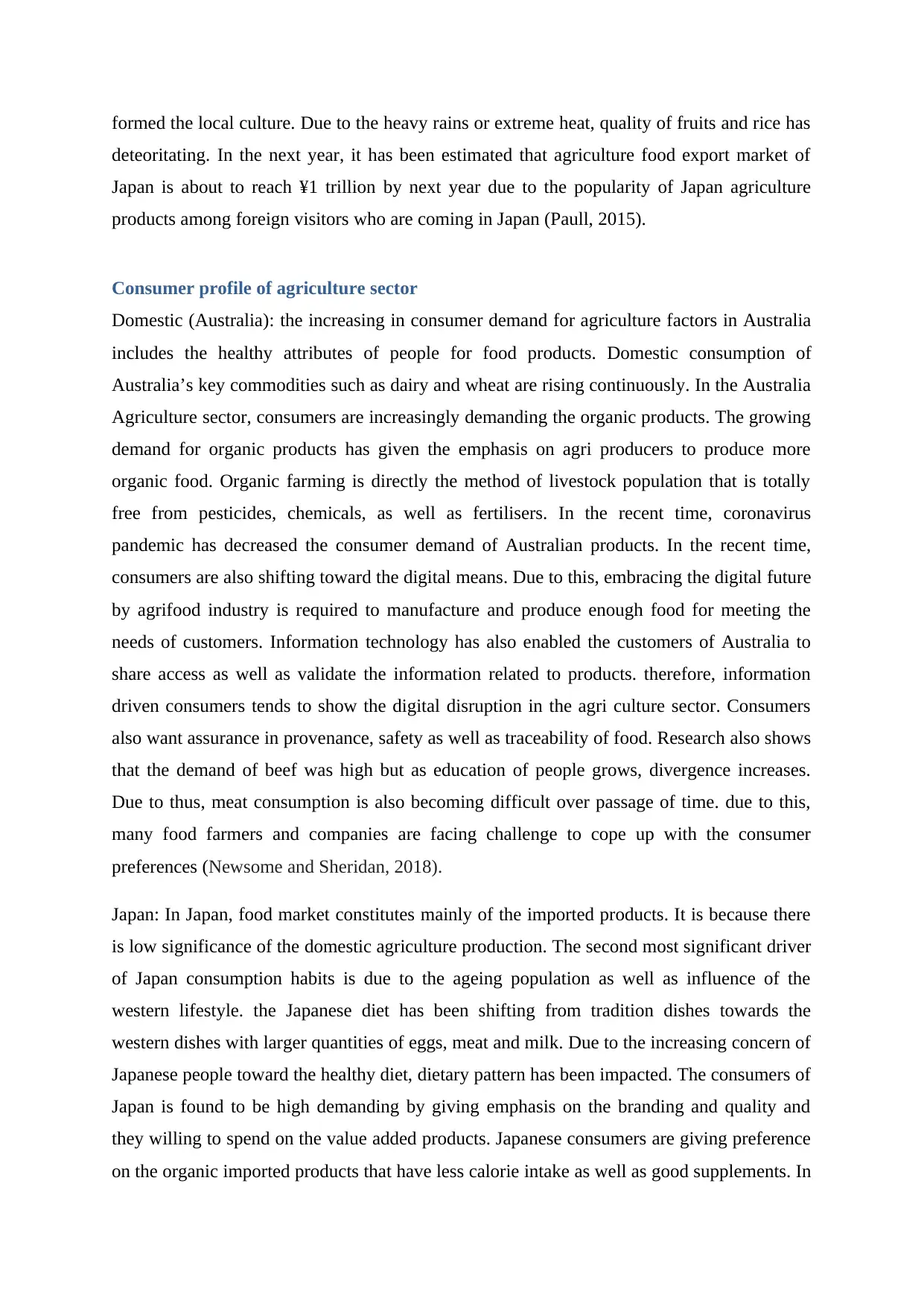
formed the local culture. Due to the heavy rains or extreme heat, quality of fruits and rice has
deteoritating. In the next year, it has been estimated that agriculture food export market of
Japan is about to reach ¥1 trillion by next year due to the popularity of Japan agriculture
products among foreign visitors who are coming in Japan (Paull, 2015).
Consumer profile of agriculture sector
Domestic (Australia): the increasing in consumer demand for agriculture factors in Australia
includes the healthy attributes of people for food products. Domestic consumption of
Australia’s key commodities such as dairy and wheat are rising continuously. In the Australia
Agriculture sector, consumers are increasingly demanding the organic products. The growing
demand for organic products has given the emphasis on agri producers to produce more
organic food. Organic farming is directly the method of livestock population that is totally
free from pesticides, chemicals, as well as fertilisers. In the recent time, coronavirus
pandemic has decreased the consumer demand of Australian products. In the recent time,
consumers are also shifting toward the digital means. Due to this, embracing the digital future
by agrifood industry is required to manufacture and produce enough food for meeting the
needs of customers. Information technology has also enabled the customers of Australia to
share access as well as validate the information related to products. therefore, information
driven consumers tends to show the digital disruption in the agri culture sector. Consumers
also want assurance in provenance, safety as well as traceability of food. Research also shows
that the demand of beef was high but as education of people grows, divergence increases.
Due to thus, meat consumption is also becoming difficult over passage of time. due to this,
many food farmers and companies are facing challenge to cope up with the consumer
preferences (Newsome and Sheridan, 2018).
Japan: In Japan, food market constitutes mainly of the imported products. It is because there
is low significance of the domestic agriculture production. The second most significant driver
of Japan consumption habits is due to the ageing population as well as influence of the
western lifestyle. the Japanese diet has been shifting from tradition dishes towards the
western dishes with larger quantities of eggs, meat and milk. Due to the increasing concern of
Japanese people toward the healthy diet, dietary pattern has been impacted. The consumers of
Japan is found to be high demanding by giving emphasis on the branding and quality and
they willing to spend on the value added products. Japanese consumers are giving preference
on the organic imported products that have less calorie intake as well as good supplements. In
deteoritating. In the next year, it has been estimated that agriculture food export market of
Japan is about to reach ¥1 trillion by next year due to the popularity of Japan agriculture
products among foreign visitors who are coming in Japan (Paull, 2015).
Consumer profile of agriculture sector
Domestic (Australia): the increasing in consumer demand for agriculture factors in Australia
includes the healthy attributes of people for food products. Domestic consumption of
Australia’s key commodities such as dairy and wheat are rising continuously. In the Australia
Agriculture sector, consumers are increasingly demanding the organic products. The growing
demand for organic products has given the emphasis on agri producers to produce more
organic food. Organic farming is directly the method of livestock population that is totally
free from pesticides, chemicals, as well as fertilisers. In the recent time, coronavirus
pandemic has decreased the consumer demand of Australian products. In the recent time,
consumers are also shifting toward the digital means. Due to this, embracing the digital future
by agrifood industry is required to manufacture and produce enough food for meeting the
needs of customers. Information technology has also enabled the customers of Australia to
share access as well as validate the information related to products. therefore, information
driven consumers tends to show the digital disruption in the agri culture sector. Consumers
also want assurance in provenance, safety as well as traceability of food. Research also shows
that the demand of beef was high but as education of people grows, divergence increases.
Due to thus, meat consumption is also becoming difficult over passage of time. due to this,
many food farmers and companies are facing challenge to cope up with the consumer
preferences (Newsome and Sheridan, 2018).
Japan: In Japan, food market constitutes mainly of the imported products. It is because there
is low significance of the domestic agriculture production. The second most significant driver
of Japan consumption habits is due to the ageing population as well as influence of the
western lifestyle. the Japanese diet has been shifting from tradition dishes towards the
western dishes with larger quantities of eggs, meat and milk. Due to the increasing concern of
Japanese people toward the healthy diet, dietary pattern has been impacted. The consumers of
Japan is found to be high demanding by giving emphasis on the branding and quality and
they willing to spend on the value added products. Japanese consumers are giving preference
on the organic imported products that have less calorie intake as well as good supplements. In
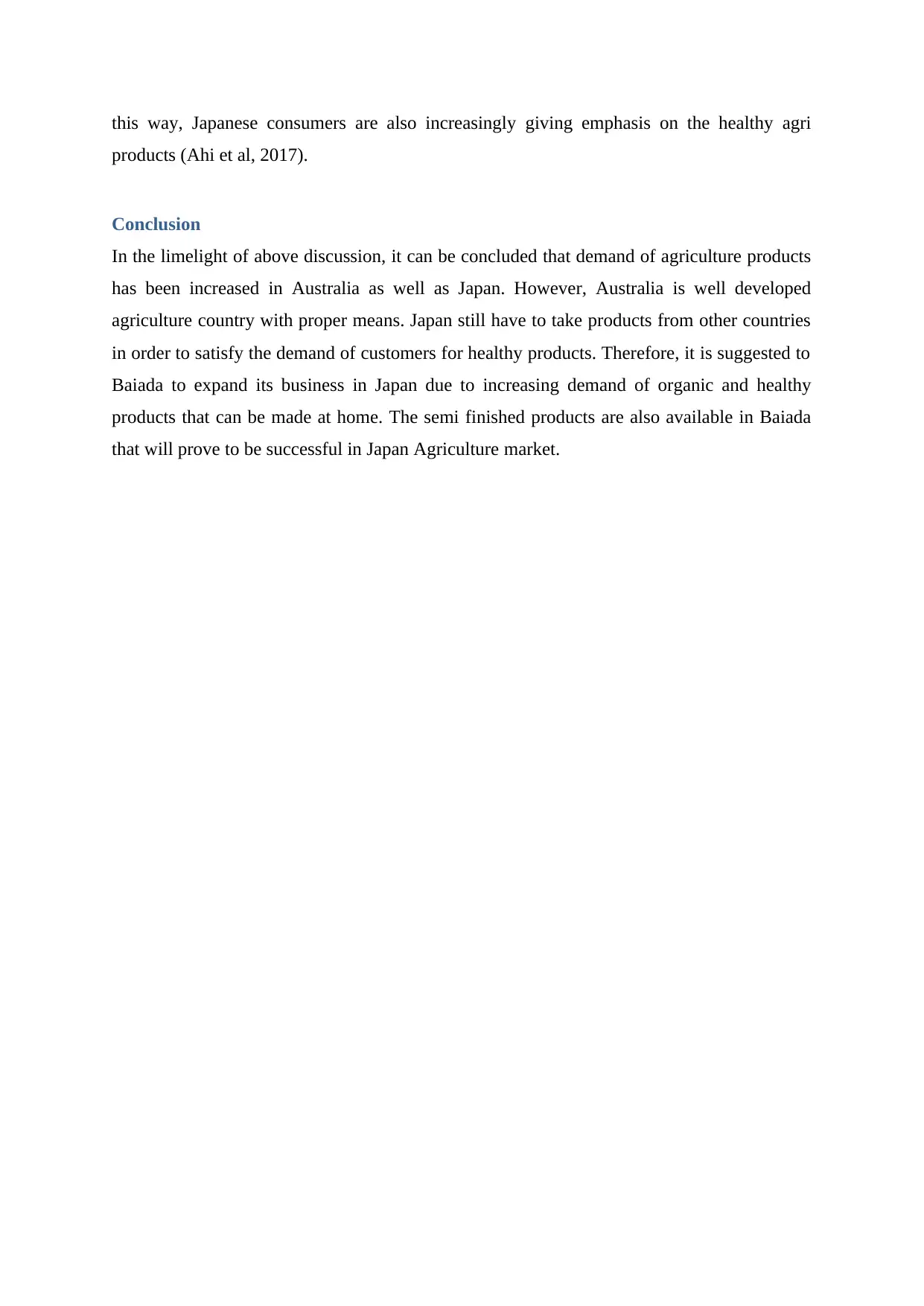
this way, Japanese consumers are also increasingly giving emphasis on the healthy agri
products (Ahi et al, 2017).
Conclusion
In the limelight of above discussion, it can be concluded that demand of agriculture products
has been increased in Australia as well as Japan. However, Australia is well developed
agriculture country with proper means. Japan still have to take products from other countries
in order to satisfy the demand of customers for healthy products. Therefore, it is suggested to
Baiada to expand its business in Japan due to increasing demand of organic and healthy
products that can be made at home. The semi finished products are also available in Baiada
that will prove to be successful in Japan Agriculture market.
products (Ahi et al, 2017).
Conclusion
In the limelight of above discussion, it can be concluded that demand of agriculture products
has been increased in Australia as well as Japan. However, Australia is well developed
agriculture country with proper means. Japan still have to take products from other countries
in order to satisfy the demand of customers for healthy products. Therefore, it is suggested to
Baiada to expand its business in Japan due to increasing demand of organic and healthy
products that can be made at home. The semi finished products are also available in Baiada
that will prove to be successful in Japan Agriculture market.
⊘ This is a preview!⊘
Do you want full access?
Subscribe today to unlock all pages.

Trusted by 1+ million students worldwide
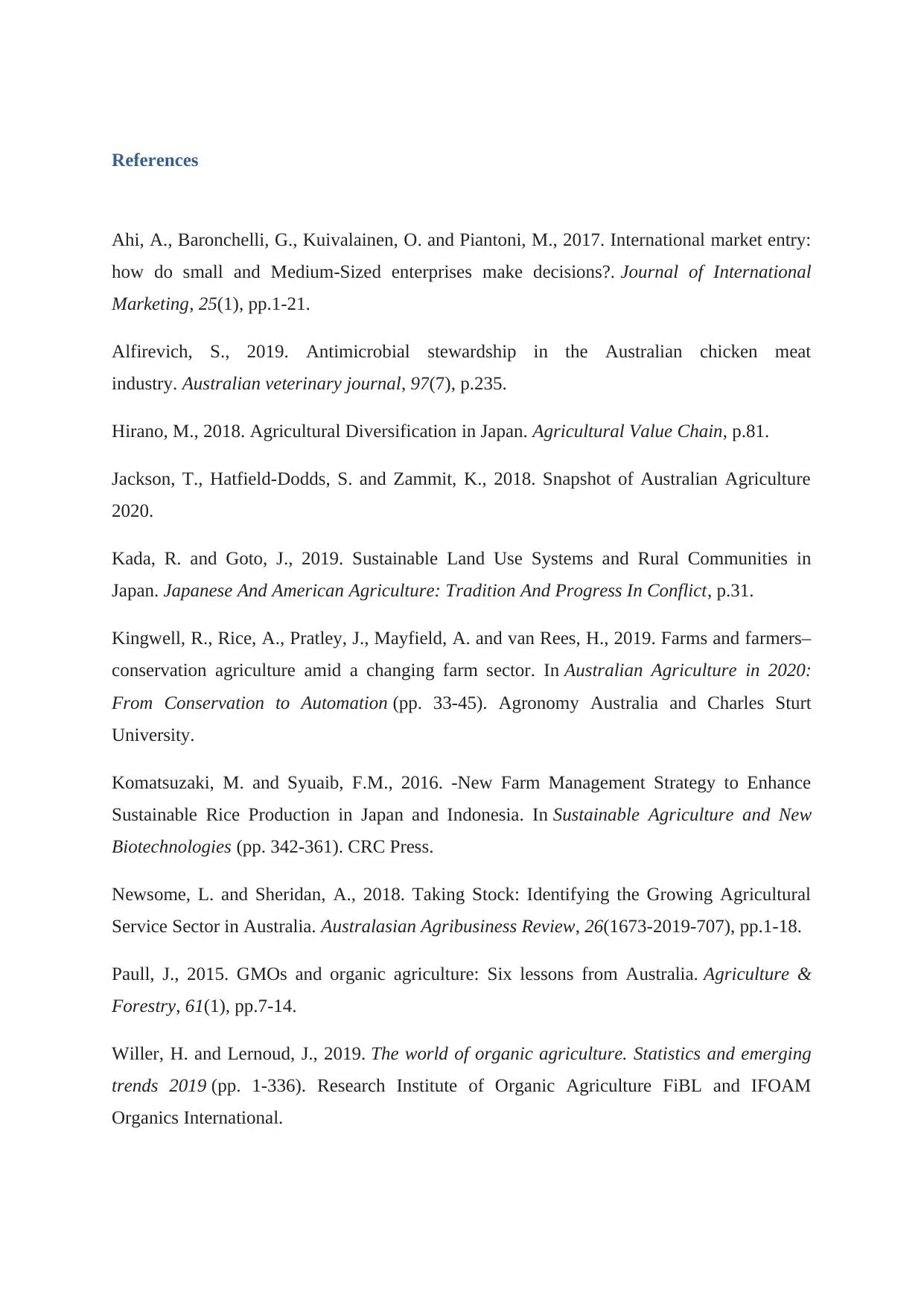
References
Ahi, A., Baronchelli, G., Kuivalainen, O. and Piantoni, M., 2017. International market entry:
how do small and Medium-Sized enterprises make decisions?. Journal of International
Marketing, 25(1), pp.1-21.
Alfirevich, S., 2019. Antimicrobial stewardship in the Australian chicken meat
industry. Australian veterinary journal, 97(7), p.235.
Hirano, M., 2018. Agricultural Diversification in Japan. Agricultural Value Chain, p.81.
Jackson, T., Hatfield-Dodds, S. and Zammit, K., 2018. Snapshot of Australian Agriculture
2020.
Kada, R. and Goto, J., 2019. Sustainable Land Use Systems and Rural Communities in
Japan. Japanese And American Agriculture: Tradition And Progress In Conflict, p.31.
Kingwell, R., Rice, A., Pratley, J., Mayfield, A. and van Rees, H., 2019. Farms and farmers–
conservation agriculture amid a changing farm sector. In Australian Agriculture in 2020:
From Conservation to Automation (pp. 33-45). Agronomy Australia and Charles Sturt
University.
Komatsuzaki, M. and Syuaib, F.M., 2016. -New Farm Management Strategy to Enhance
Sustainable Rice Production in Japan and Indonesia. In Sustainable Agriculture and New
Biotechnologies (pp. 342-361). CRC Press.
Newsome, L. and Sheridan, A., 2018. Taking Stock: Identifying the Growing Agricultural
Service Sector in Australia. Australasian Agribusiness Review, 26(1673-2019-707), pp.1-18.
Paull, J., 2015. GMOs and organic agriculture: Six lessons from Australia. Agriculture &
Forestry, 61(1), pp.7-14.
Willer, H. and Lernoud, J., 2019. The world of organic agriculture. Statistics and emerging
trends 2019 (pp. 1-336). Research Institute of Organic Agriculture FiBL and IFOAM
Organics International.
Ahi, A., Baronchelli, G., Kuivalainen, O. and Piantoni, M., 2017. International market entry:
how do small and Medium-Sized enterprises make decisions?. Journal of International
Marketing, 25(1), pp.1-21.
Alfirevich, S., 2019. Antimicrobial stewardship in the Australian chicken meat
industry. Australian veterinary journal, 97(7), p.235.
Hirano, M., 2018. Agricultural Diversification in Japan. Agricultural Value Chain, p.81.
Jackson, T., Hatfield-Dodds, S. and Zammit, K., 2018. Snapshot of Australian Agriculture
2020.
Kada, R. and Goto, J., 2019. Sustainable Land Use Systems and Rural Communities in
Japan. Japanese And American Agriculture: Tradition And Progress In Conflict, p.31.
Kingwell, R., Rice, A., Pratley, J., Mayfield, A. and van Rees, H., 2019. Farms and farmers–
conservation agriculture amid a changing farm sector. In Australian Agriculture in 2020:
From Conservation to Automation (pp. 33-45). Agronomy Australia and Charles Sturt
University.
Komatsuzaki, M. and Syuaib, F.M., 2016. -New Farm Management Strategy to Enhance
Sustainable Rice Production in Japan and Indonesia. In Sustainable Agriculture and New
Biotechnologies (pp. 342-361). CRC Press.
Newsome, L. and Sheridan, A., 2018. Taking Stock: Identifying the Growing Agricultural
Service Sector in Australia. Australasian Agribusiness Review, 26(1673-2019-707), pp.1-18.
Paull, J., 2015. GMOs and organic agriculture: Six lessons from Australia. Agriculture &
Forestry, 61(1), pp.7-14.
Willer, H. and Lernoud, J., 2019. The world of organic agriculture. Statistics and emerging
trends 2019 (pp. 1-336). Research Institute of Organic Agriculture FiBL and IFOAM
Organics International.
1 out of 7
Related Documents
Your All-in-One AI-Powered Toolkit for Academic Success.
+13062052269
info@desklib.com
Available 24*7 on WhatsApp / Email
![[object Object]](/_next/static/media/star-bottom.7253800d.svg)
Unlock your academic potential
Copyright © 2020–2025 A2Z Services. All Rights Reserved. Developed and managed by ZUCOL.





